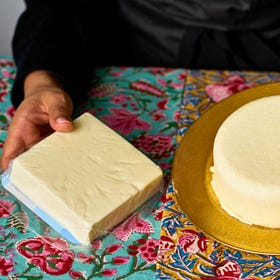If you've ever wondered why restaurant butter paneer has that impossibly smooth, velvety texture while your homemade version never quite measures up, you're not alone. I spent years trying to crack this code, even doubling the cream in my recipe, thinking that was the secret. Spoiler alert: it wasn't.
After countless attempts, I've uncovered three techniques that will transform your butter paneer from homemade to restaurant-quality. These aren't just ingredient tweaks – they're professional techniques that create that luxurious texture you've been craving.
Technique #1: The Real Creamy Foundation
When I first started making butter paneer, I made the classic mistake of thinking more cream and butter equaled better results. I'd double the cream in my sauce, ending up with a dish that was heavy yet somehow bland, with all that dairy drowning out the delicate spices.
The real secret to achieving that inherent creaminess? Cashew nuts.
While butter and cream are still important, cashews are the unsung hero of restaurant-style butter paneer. When blended into the sauce, they do two important things:
They create natural creaminess without relying solely on dairy
They act as a thickening agent, giving the sauce its characteristic velvety texture
This technique allows restaurants to create rich, creamy sauces that don't feel heavy or overly dairy-laden.
Technique #2: The Game-Changing Step I Initially Laughed At
Sometimes the most transformative techniques are the ones that seem unnecessary at first. I learned this lesson watching my favorite Indian chef, Ranveer Brar, prepare butter paneer. When I saw him strain the already-smooth sauce, I actually chuckled, thinking it was overkill.
After multiple failed attempts to replicate restaurant-quality texture, I finally gave in and tried straining. The difference was remarkable.
Here's why this step matters:
Even high-powered blenders (I use a Vitamix) can't achieve the ultra-silky texture of restaurant butter paneer
Straining removes any tiny particles, creating that uniform smoothness
It's the difference between "smooth" and "professionally smooth"
Pro tip: Use any strainer you have on hand and press the sauce through with a flexible spatula. This ensures you get maximum yield while achieving that coveted texture.
Technique #3: The Two-Second Technique I Discovered by Accident
While looking through an Old Delhi restaurant kitchen window, I noticed the chef added a small knob of butter to the already-finished dish.
This final touch might seem redundant – after all, it's called butter paneer – but it serves a specific purpose:
Add the butter off the heat, letting it melt gently from residual warmth
This creates a glossy, professional sheen that distinguishes restaurant preparations
The melted butter adds a final layer of richness that coats every bite
It takes just seconds but elevates the entire dish from home-cooked to restaurant-quality.
Why Understanding the "Why" Matters
These techniques might seem simple, but understanding the reasoning behind each step opens up a world of possibilities. When you grasp why cashews create creaminess, why straining achieves silkiness, and why that final butter addition creates the perfect finish, you're not just following a recipe – you're mastering a technique.
This deeper understanding is what I focus on teaching in my program, where I help Indian Americans reconnect with their culinary heritage through authentic techniques like these. Because preserving our food traditions isn't just about following recipes – it's about understanding the wisdom behind them.
Your Turn to Create Restaurant Magic
Ready to put these secrets into practice? Here's your action plan:
Start with quality cashews for natural creaminess
Don't skip the straining step – your sauce will thank you
Finish with that glossy butter technique off the heat
And remember, the paneer itself matters too. Whether you choose homemade or store-bought can significantly impact your final dish and I wrote all about that in this post.
Can You Actually Taste the Difference?
Ever wondered why store-bought paneer often feels like rubber? After countless experiments with American ingredients, I finally figured out how to make the perfect paneer at home.
If you’d like the recipe, respond to this email with ‘recipe’ and I’ll send it over.




Recipe!